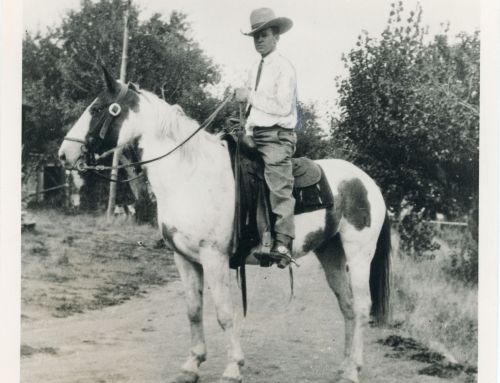In our last blog post, we explored Charles Russell’s friendships with a couple of well-known artists, Maynard Dixon and Philip Goodwin, the latter of which Russell collaborated with on an art project at his summer cabin.
Other artists and friends Russell collaborated with include Russell’s close friend and first serious art dealer Charles Schatzlein and Butte artist Edgar S. Paxon. The three Montanans painted a portrait of an American Indian, which our museum visitors will see on display in our current exhibit, Charles M. Russell: Storyteller Across Media. Schatzlein owned the Schatzlein Paint Company in Butte, Montana and admired Russell’s work. He owned a number of Russell’s and exhibited several of his works in the store from the mid-1890s onward. Russell respected Paxson, admitting that Paxson had been able to claim achievements in his art that Russell felt he could not do. When it comes to the 1904 Indian Head, between the three artists it is difficult to know who painted what. However, the work is a testament to the collective nature of works made like this among friends. This same team of artists would collaborate again in 1906 on a mural that decorated Schatzlein’s dining room.

Indian Head | Charles M. Russell, Edgar S. Paxon and Chas Schatzlein | 1904 | Watercolor, pencil & gouache on paper | 15.25 x 9.25 inches
Sometimes Russell incorporated his friends and acquaintances into his artworks, as seen in his 1907 painting Utica, also featured in our current exhibit. In the painting Russell leans on the hitching post just in front of his old friend Jake Hoover. Charles Lehman, owner of the general store and patron of this painting, lounges in the doorway while cowboy Frank Hartzell rides his bucking horse. Drawn from his early days on the roundup near this small Montana town, this scene has its origins in a letter Russell wrote to his friend William R. McDonough around 1899. In the drawing that accompanied the letter, Russell included a bucking horse and rider, a tin-canned dog, and fleeing chickens. The scene likely draws upon an event or story that Russell knew from his days cowboying when he was close friends with McDonough.

Utica (A Quiet Day in Utica) | Charles M. Russell | 1907 | Oil on canvas | 24.125 x 36.125 inches

Cowboys and Bank Saloon – Letter to William R. “Bill” McDonough, ca.1899, Ink on paper, Courtesy of the Montana Historical Society, 1980.46.02 a-b
Some paintings Russell made as a gift to friends, and such is the case with his 1916 painting Man’s Weapons are Useless When Nature Goes Armed. Featured in our current exhibit, this amusing oil was inscribed as a thank you to Russell’s good friend, Howard Eaton, a pioneer dude rancher, after Russell rode with Eaton on a particularly memorable trip through Arizona and along the Grand Canyon in October, 1916. This painting is a great example of Russell’s sense of humor. Here, the two hunters return to a campsite left in an absolute mess. For one of our volunteer docents, who was a Scoutmaster for Boy Scouts for several years, he interprets this painting as representative of what NOT to do when camping.

Charles Russell, Man’s Weapons Are Useless When Nature Goes Armed, 1916, Oil on canvas, 30 inches x 48 1/8 inches

Detail of Russell’s inscription to Howard Eaton
Although he enjoyed international acclaim as the “original cowboy artist,” Charlie humbly valued his relationships above all else. The infectious humor, gifted storytelling, and illustrated “paper talk” letters he shared with friends continue to delight viewers as they once delighted their original recipients.

Maney Snows Have Fallen…(Letter from Ah-Wa-Cous (Charles Russell) to Short Bull) | Charles M. Russell | c. 1909-10 | Watercolor, pen & ink on paper | 8 x 10 inches






The Utica painting reveals a romantic side to old Montana. 7/19/23